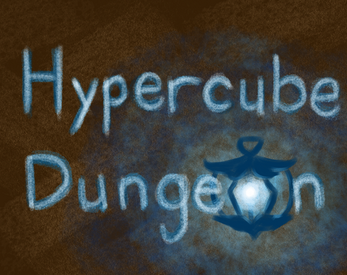Hypercube Dungeon
Navigate the Hypercube Dungeon and find all five number tiles in order—but be wary of the icy lantern monster that roams the caverns.
A blue filter indicates the icy lantern is in an adjacent room. Follow the blue light in the doorways to find the lantern. Be aware that rivers and waterfalls freeze when the lantern is nearby, and while rivers are frozen they can be traversed. But YOU can also freeze if you enter the glow of the lantern—in that case, refresh the page to try the game again.
This game prototype was created by Evan Charfauros in the span of 36 hours at LA Hacks 2019, a large-scale hackathon hosted at UCLA. The prototype uses the Unity engine with entirely original code, art, and music. Art assets and code were developed during the hackathon and the music was composed afterward.
The game serves as a proof of concept for a theoretical future full release. Evan set out to create a dungeon setting that doesn't adhere to the usual laws of Euclidean space. The grid-like layout of the rooms is deceiving; for example, should a player travel right, down, left, and up in that order, they will not end up in the same room that they started in like they might expect. This is because the layout of the rooms adheres to the graph-theory concept of a hypercube (inspired by a lecture on the subject in Evan's Discrete Math class).
Warning: Math Incoming!
For those interested who are not already familiar, an n-dimensional hypercube is a graph in which all possible n-length combinations of zeros and ones is assigned to a node. For example, a 2D hypercube has 4 nodes labeled 00, 01, 10, and 11. The edges of a hypercube connect any two nodes whose labels differ by one digit. 00 and 01 differ in the second digit only, so they're connected by an edge, but 00 and 11 differ in both digits, so they don't share an edge. As a result, the 2D hypercube has four edges that connect the four nodes in a cycle. In layman's terms, a 2D hypercube is a square. Now, what does this have to do with the game above? Well, the rooms in the game are laid out to represent a 4D hypercube (sometimes referred to as a tesseract).
The rooms in the dungeon correspond to nodes of the graph while the doors represent edges. So the player starts in room 0000 and can take the red door to enter room 1000 or the blue door to enter room 0010, etc. In fact, each door color is tied to a numeric dimension in our supposed cube, so each time a player enters a red door they flip the first digit of their room address, second with yellow, etc. This means the player can access any of the sixteen rooms in the dungeon by going through at most four doors. The game's challenge is intended to arise from keeping one's bearings in this setup.
| Status | Released |
| Platforms | HTML5 |
| Author | Evan Charfauros |
| Made with | Unity |
| Tags | 2D, Roguelike |
| Average session | A few minutes |

Comments
Log in with itch.io to leave a comment.
Because the doors are colored, a player can mentally undo the rotational effects of triangulation and model the map not as a hypercube but as a linked list sort of like a tree data structure. This makes navigation more-or-less equivalent to a non-euclidean 2D rather than 4?D space. In particular it reminded me of the apple orchards in Hyper Rogue but with a finite amount of space and wrapping.